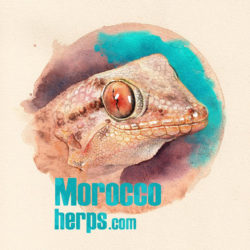By Francisco Silva & Marco Caetano
(Link for trip video at the end of the trip report)
Marco and I have known each other since 2007 – he has taught me most of what I know about snakes today! We have made a few herping trips in Portugal, but this was our first international trip together.
DAY 1 (09.05) – Sevilla – Agadir
Since we are from the south of Portugal and the flight prices were conveniently cheap, we flew from Seville to Agadir. We landed at around 18h00, picked up the car, and went straight to the hotel to check-in. After dinner, we decided to explore some hills just north of the city. We saw Tarentola mauritanica, Sclerophrys mauritanica and 21 individuals of Saurodactylus brosseti.






DAY 2 (10.05) – Agadir – Sidi Ifni
On the second day, we drove to the legendary herping paradise Sidi Ifni. We stopped a few times along the road and climbed down the first water tank/cistern (hereafter aljibe) of the trip. On the way we found a few Pelophylax saharicus, Mauremys leprosa saharica, Saurodactylus brosseti, Tarentola mauritanica and Chalcides mionecton. Before getting to Sidi Ifni, we saw the first snake of the trip: a Dasypeltis sahelensis, sadly dead on the road (DOR).


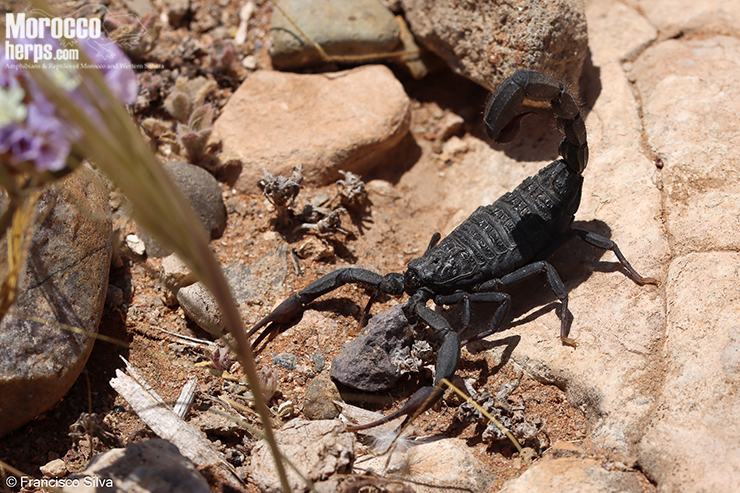





I was sick at the beginning of our trip, so we ended up keeping the nights short. This first evening was cold and foggy, but still, we decided to drive around to see what we would find. Despite the weather, we found a 71 cm long Dasypeltis sahelensis on the road (quite a large size for this species!), Tarentola chazaliae and Bufotes boulengeri.


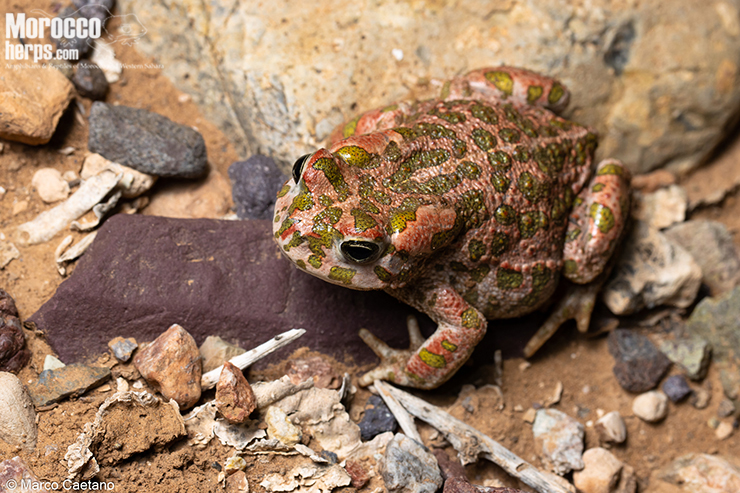



DAY 3 (11.05) – Sidi Ifni and Plage Blanche
We left the hotel to go check both aljibes and habitat during the day. Just as we were leaving Sidi Ifni we saw a Macroprotodon brevis DOR. The aljibes did not produce a lot of results besides Agama bibronii, Chalcides polylepis and Barbarophryne brongersmai. Searching habitats, however, we saw Agama bibronii, Tarentola mauritanica, Saurodactylus harrisii, a North African Elephant Shrew (Petrosaltator rozeti), lots of Little Owls (Athene noctua), and a large (156 cm long) beautiful Hemorrhois hippocrepis on a stone wall, at the hottest time of the day. Shortly after that we saw our only Mesalina simoni of the trip. We spent some time in the early evening searching for animals on a river bed, particularly Daboia mauritanica and Naja haje, but were not successful: we only found Tarentola mauritanica.


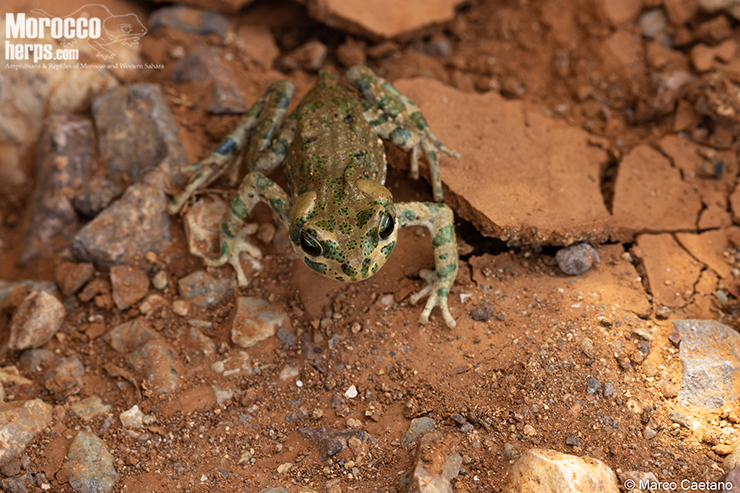


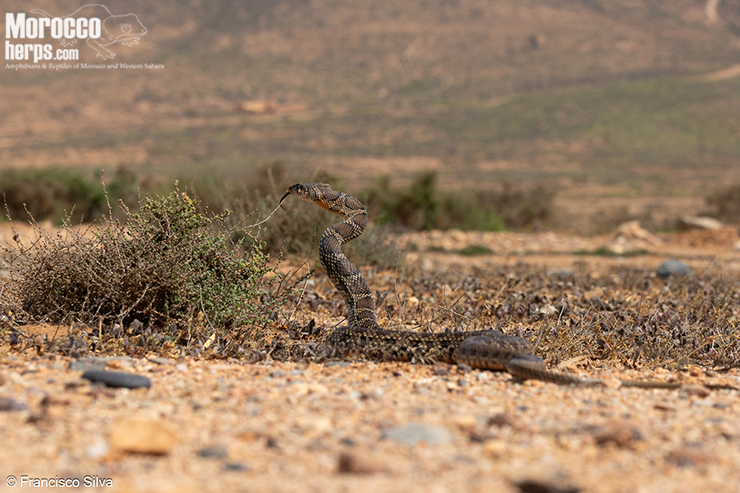


In the late afternoon it rained a little and there were thunderstorms around us. Besides, the winds were quickly changing direction and the temperature had oddly started to rise after sunset. At around midnight it was over 30 degrees celcius. We think all of this helped with the activity levels of some of the species we found next. That night we searched for herps around Plage Blanche and Sidi Ifni, looking mostly for Bitis airetans. We found three more large Dasypeltis sahelensis: the first one was 68 cm long, the second 69 cm, and the last one – recently run over by a car – was 74 cm long! We also saw Tarentola chazaliae and Tarentola mauritanica.
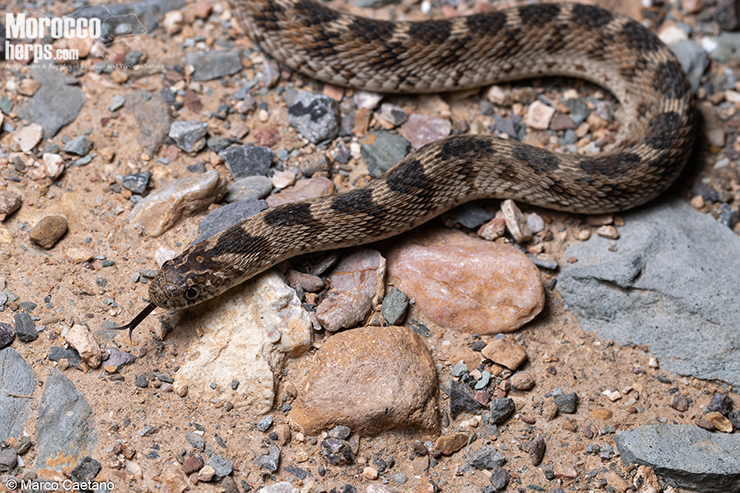

As we were ready to call it a night, we were presented with our first (and only one alive) Bitis arietans! This beautiful individual was lying on the road as we drove past, and could see what it was from afar. We took it out of the road, and took some (really, really poor) photos. The viper was not aggressive at all and cooperated throughout the whole process. After seeing this beauty, we could sleep a lot better!




Plage Blanche
At night, before we found the snakes above, we were looking for snake tracks on the sand dunes that were engulfing the small houses by the beach. At some point, we heard someone shouting and coming our way. It was a very dark night and that person was not carrying any lights. As the person approached, we could see a somewhat confused man staggering our way. He was carrying a box of dates that he accidentally dropped as he reached us. He seemed to speak only Arabic – or some berber language – and some French, and we assumed he was trying to sell the dates. We politely tried to explain that we were not interested in buying anything. He seemed a bit agitated by that and started shouting as if to call someone (that never showed!). He then threw himself onto the ground, filled his hand with sand and then let the sand fall slowly through his fingers. As he did this, he was speaking, and we could only make out the French words ‘sable noir’ (black sand). The situation got a little bit uncomfortable as he was seemingly becoming aggressive (and kept on calling someone else), so we tried to politely say goodnight, turned our backs, and slowly (but steadily) started moving towards the car. As we walked, we could hear him coming shortly behind, following us (in the darkness!). We sped up (and so did he!), finally got to the car, went inside, and locked the car doors quickly. When I started the car and switched on the lights, I looked to my left and saw his face a few centimeters away from mine on the other side of the window. We hurriedly drove away… Was he dangerous? We do not know, but we left the place that had a great potential for herps without seeing any snake (nor snake track), and with this weird story to tell.
DAY 4 (12.05) – Sidi Ifni-Guelmin
On this day, we decided to drive towards Guelmim and to check aljibes and habitat on the way. Shortly after leaving, we saw a Trogonophis wiegmanni DOR. It was one of the goals of the trip, and sadly the only specimen we found. We also stopped on a small aljibe right by the road from which we rescued a shrew (Crocidura sp.).
Since most aljibes had a lot of water, we had not climbed down on so many until we saw an inviting one by the road, and decided to check it out. As we stopped the car and reached for our large bucket that had the rope ladder and helmet (safety first!) inside, we realized it was not there – WE HAD FORGOTTEN THE FU**ING BUCKET (who does that?!) at some aljibe on the previous day. We spent most of the day checking the places we went to the day before, but could not find the bucket. We decided it was time to face the truth: we were never going to see the nice Decathlon climbing rope ladder that Marco had kindly built ever again! We drove back to Sidi Ifni – and barely got there, as we were running out of gas – and started looking for a new bucket, helmet, and a 60m long rope (that would be thick enough to build a ladder). Luckily, it was very easy to find everything; the worst part was building the ladder again.

Early in the evening we drove to Guelmim. On the way we saw a dead Eumeces algeriensis and Quedenfeldtia moerens, and Agama bibronii
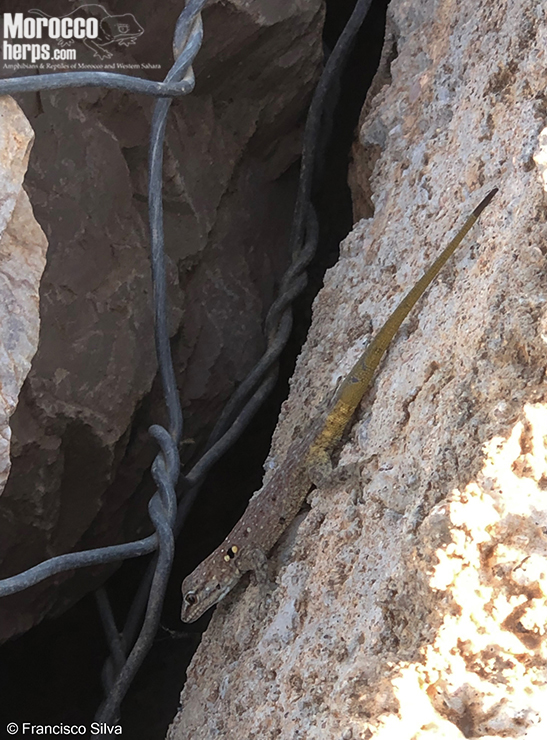


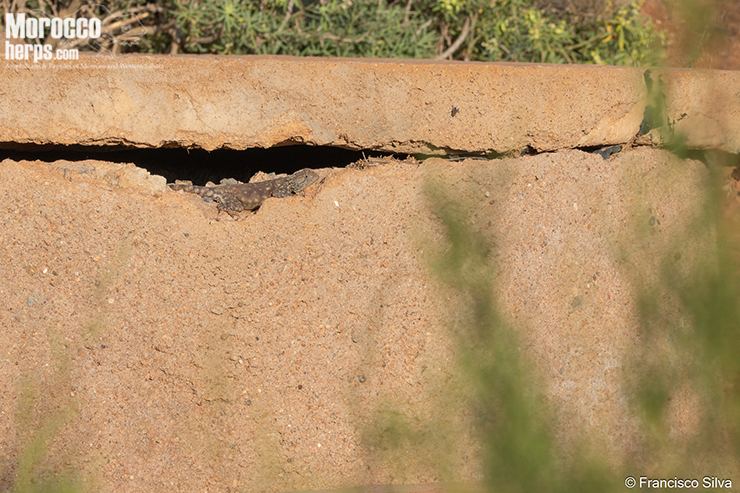
Once in Guelmim, we accidentally managed to drive right to the middle of a street market. Luckily, the vendors were kind enough to move their stalls so we could drive through. Later at night, we looked for Cerastes cerastes only to find one recently roadkilled individual and no tracks on the sand dunes. Instead, we saw the first Stenodactylus mauritanicus of the trip.

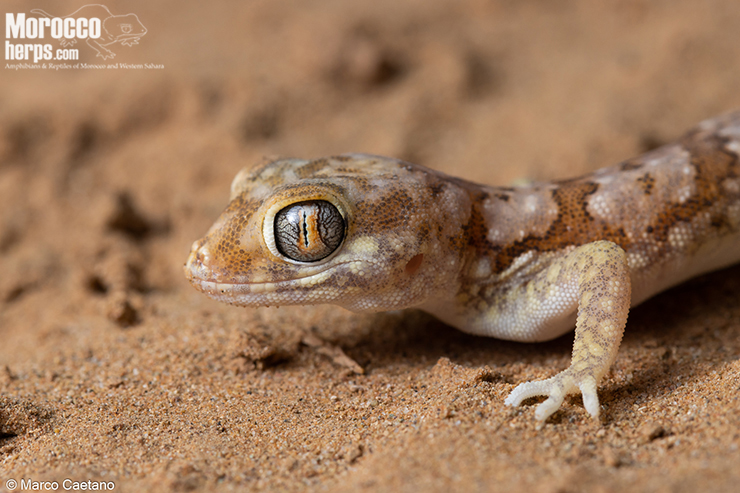

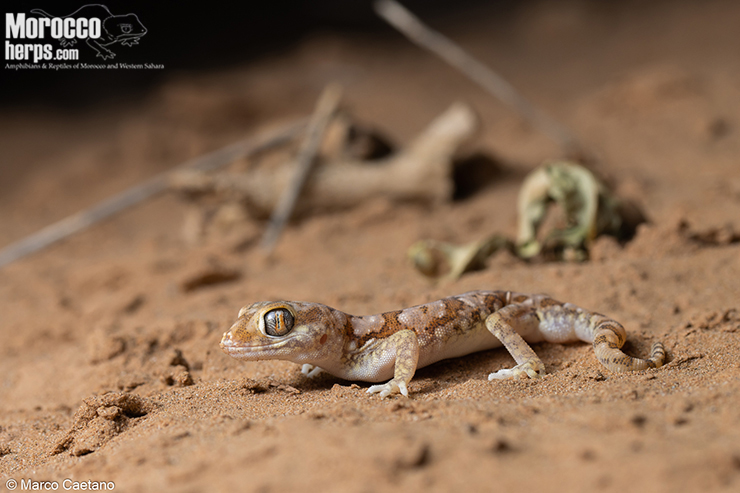
DAY 5 (13.05) – Guelmim and Tan-Tan
We started the day looking for snakes on sand dunes. We found a juvenile Malpolon monspessulanus and a few individuals of Acanthodactylus boskianus – still no Cerastes cerastes tracks.

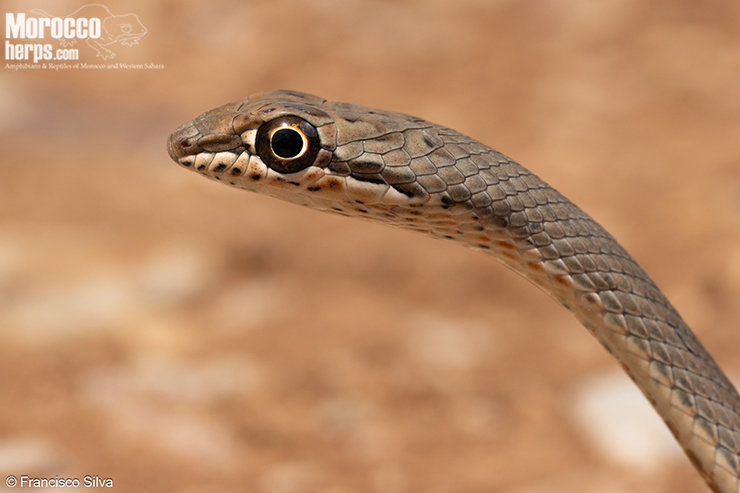

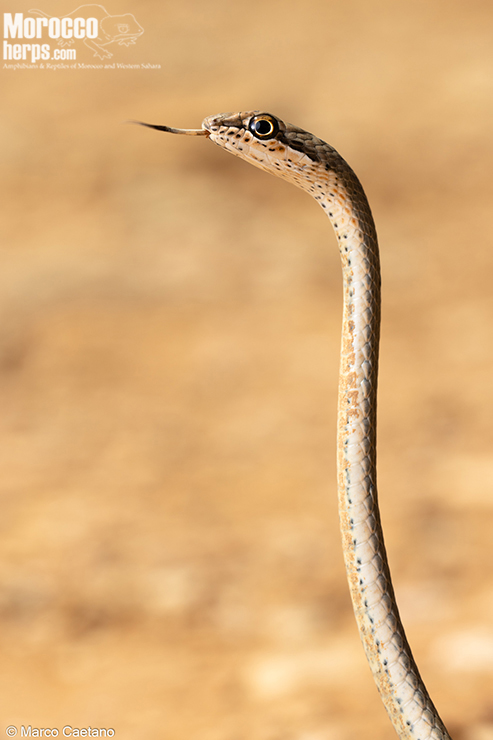
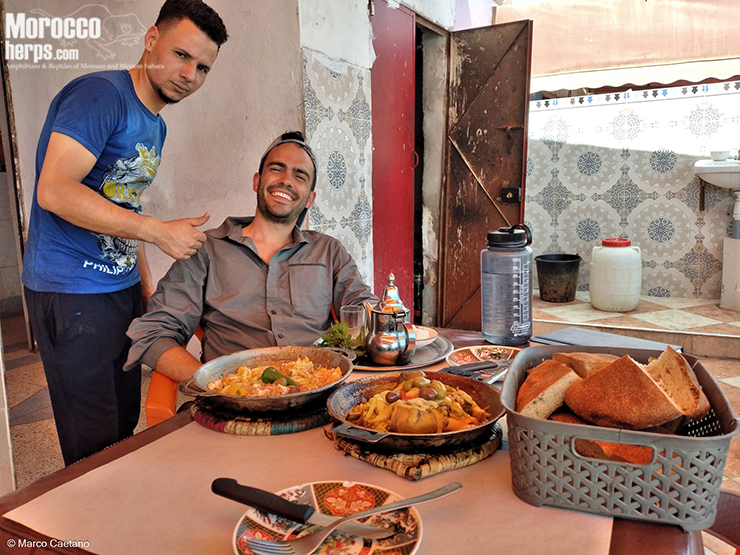


As we drove south and the aljibes were getting drier, we started seeing more animals in them, and we found our first Psammophis schokari – a beautiful juvenile that posed nicely for the photos. During the day, we rescued some more animals from aljibes – Agama bibronii, Stenodactylus mauritanicus, Bufotes boulengeri, Sclerophrys mauritanica and Barbarophryne brongersmai. At night we found Tropiocolotes algericus and a few Stenodactylus mauritanicus.
DAY 6 (14.05) – Tan-Tan
We spent this day searching around Tan-Tan and the Dra River. We saw surprisingly very few animals – mostly Acanthodactylus boskianus and Bufotes boulengeri. We also searched around a nice oasis, but only found Pelophylax saharicus. In the early evening, we found our first Uromastyx nigriventris.



At night, searching in habitat we found one more Stenodactylus mauritanicus. While road cruising, at around 22h00, we found a Boaedon fuliginosus on an old road. It was a beautiful specimen! On the way back to the hotel we found a dead Lytorhynchus diadema. We decided to search a bit longer around that same area and found an alive specimen too.


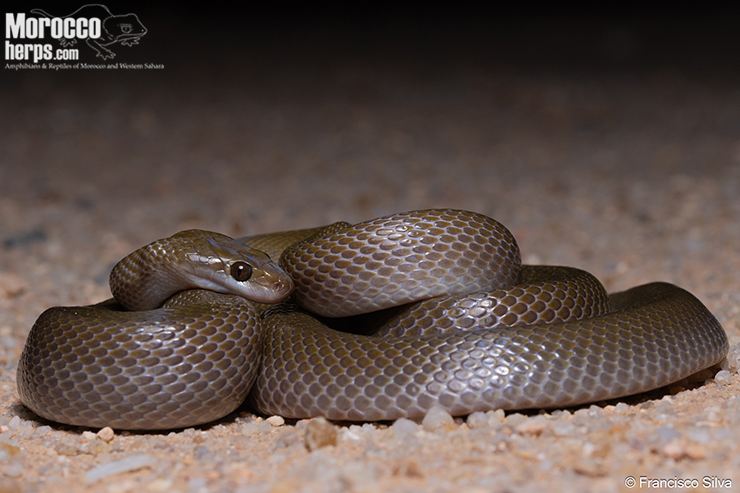





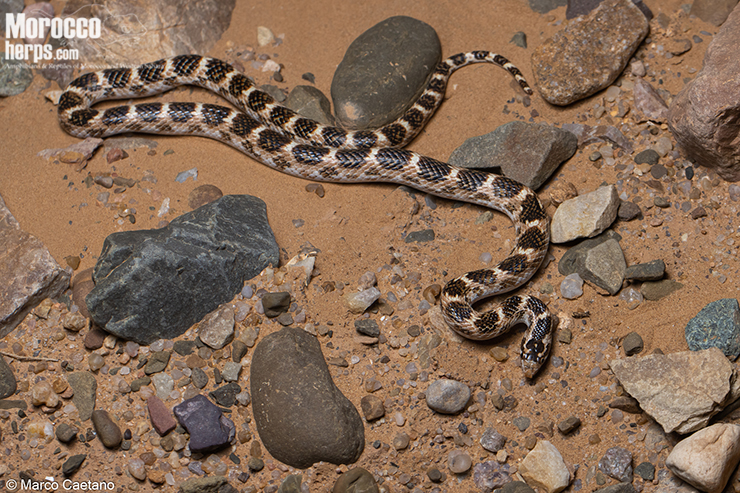

The dropped snake tong saga (part I)
As I was trying to rescue a Bufotes boulengeri from an aljibe, I accidentally dropped Marco’s snake tong inside and saw it slowly fading into the very, very deep, turbid water, never to be seen again… (to be continued…)
DAY 7 (15.05) – Tan-Tan – Smara
This day we saw the greatest change in landscape as we headed south: we had reached true desert! We also started finding more animals in aljibes: Macroprotodon brevis, Chalcides sphenopsiformis, Chalcides polylepis, Malpolon moilensis, Cerastes vipera and other common species we had already seen before. We also found many animals dead on the road: a few Malpolon moilensis, Varanus griseus (run over by a car while eating a Malpolon moilensis) and Spalerosohis diadema.

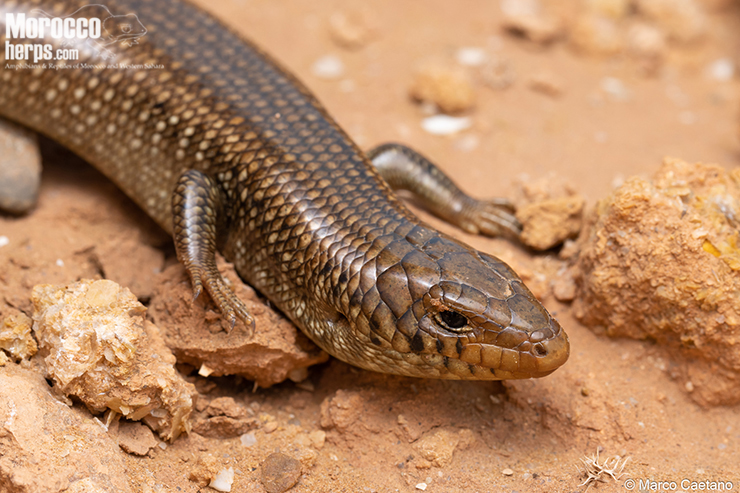


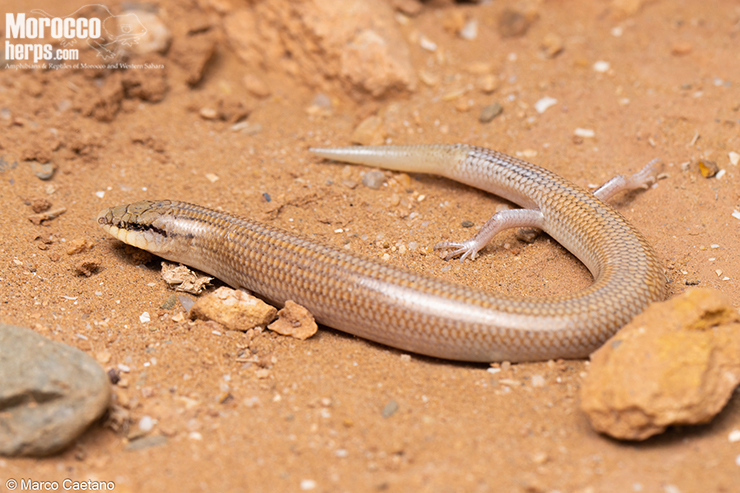







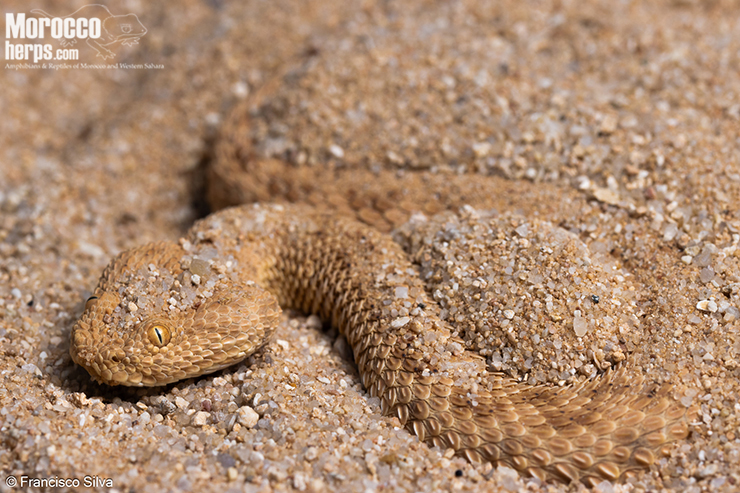



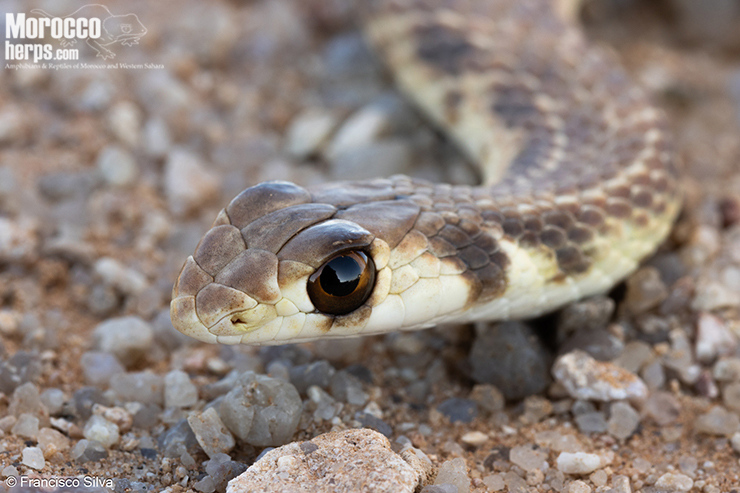
DAY 8 (16.05) – Smara – Laayoune
We started off the day with a bunch of Tarentola annularis, some of which truly large! On the road to Laayoune we did some searching in the hostile desert habitat and found Uromastyx dispar, Trapelus boehmei, three Cerastes cerastes DOR (still no alive specimen at this point) and a few Tropiocolotes algericus. At night we looked for the Cerastes vipera around Laayoune, but with no success.






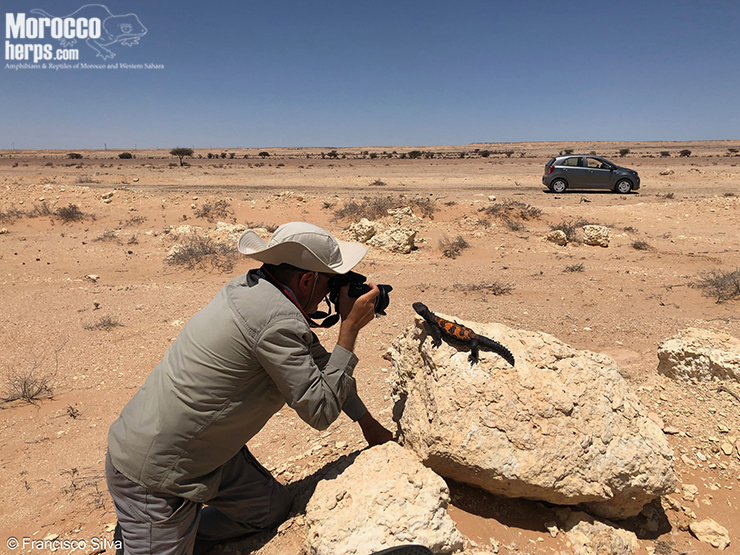


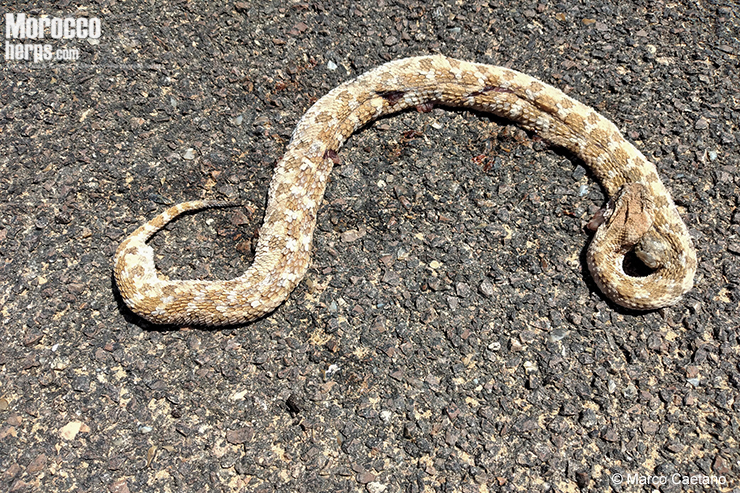

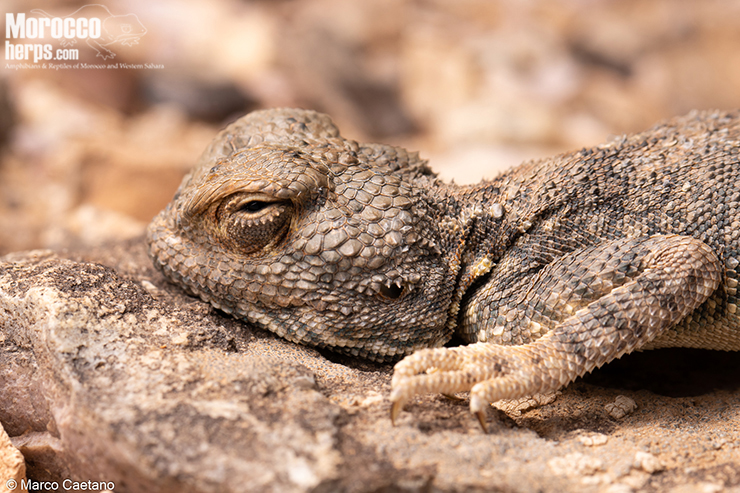
DAY 9 (17.05) – Laayoune – Tan-tan
We started our way back north, wanting to explore more of the areas around Tan-tan and Guelmim, but also Assa. It was a very mediocre day, in which we only saw two alive snakes: a Psammophis schokari and a Macroprotodon brevis found both in the same aljibe, besides a bunch of Tropiocolotes algericus, and some other animals DOR and in aljibes.





The dropped snake tong saga (part II)
(continuing…) When we got back to Tan-Tan, I felt I should make an attempt to rescue Marco’s snake tong that I had dropped down an aljibe days earlier. I asked around the hotel if anybody had a magnet I could borrow, maybe one from an old loudspeaker. A young man said he did have an old loudspeaker from which I could get the magnet. I drove him to his place and the boy did have a magnet indeed. We then drove back to the alibe where I had dropped the snake tong and, by attaching a rope to the magnet, I managed to fish the tong back!

DAY 10 (18.05) – Tan-Tan – Guelmim
With Assa in mind, we headed back towards Guelmim. On the way, we found Bufotes boulengeri, Barbarophryne brongersmai, Sclerophrys mauritanica, Saurodactylus brosseti, Chalcides polylepis, Uromastyx nigriventris, Psammophis schokari, Hemorrhois sp. (possible hybrid H. hippocrepis x H. algirus), Malpolon monspessulanus alive; and Malpolon moilensis DOR. The Malpolon monspessulanus was an enormous male. Neither Marco nor I had ever seen such a big snake in the wild – it was likely well over 2 m long. It was lying next to a dirt road, in a very isolated area, far from any settlements. We tried to take photos of it, and almost did, but it swiftly dissapeared between my feet (Olé!) and went into some rodent burrow. This snake was one of the highlights of the trip, but unfortunately we have no photos.




DAY 11 (19.05) – Guelmim – Assa
In the morning, as we were leaving Guelmim, we were surprised by an African Golden Wolf (Canis lupaster) that we managed to follow for a long time. On the drive to and around Assa we saw Sparesophis dolichospilus, Psammophis schokari, Cerastes cerastes and Uromastyx nigriventris DOR; and alive Acathodactylus boskianus, Uromastyx nigriventris and Tarentola boehmei.
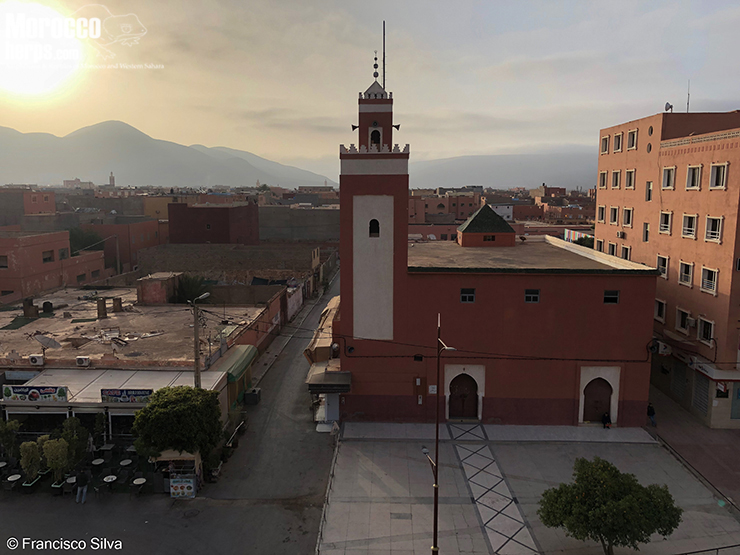



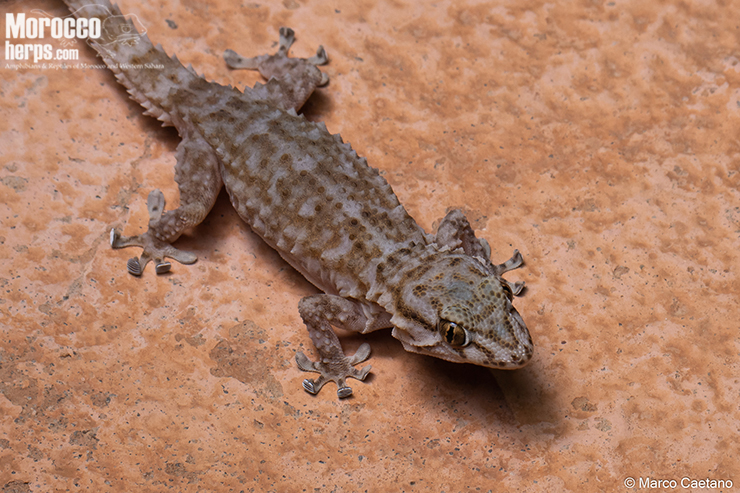
Shockingly, and after having seen quite a few dead ones, at this point we still had not seen a live Cerastes cerastes specimen (nor even tracks!!). With this in mind, at night we were determined to see them, and possibly Echis leucogaster and Telescopus tripolitanus. No luck for the latter, but we did find our first Cerastes cerastes alive crossing a road. We took a few photos and then let it go. Shortly before, we had just seen another African Golden Wolf (Canis lupaster)



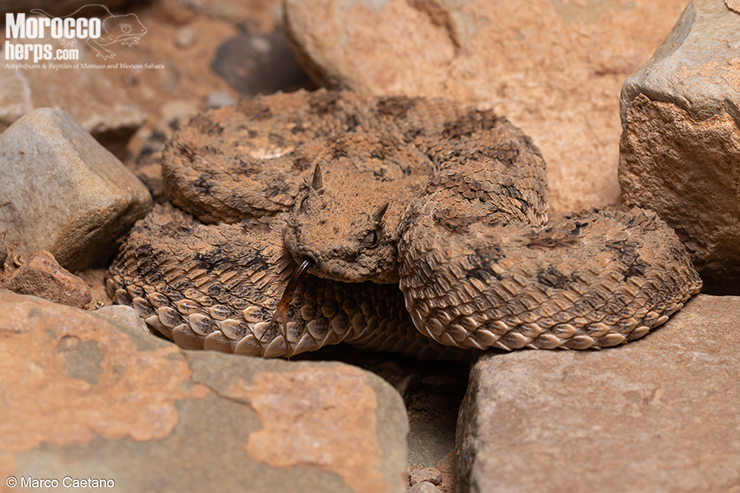





DAY 12 (20.05) – Assa – Guelmim
At this point, we were missing Sidi Ifni and decided we would like to spend the last days there. So we slowly started heading in that direction. On the way we saw Psammophis schokari, Hemorrhois sp. (possible hybrid H. hippocrepis x H. algirus), (a very large!) Malpolon monspessulanus, Trapelus boehmei, (MANY!) Uromastyx nigriventris, Agama impalearis, Chalcides ocellatus, Chalcides polylepis, Tropiocolotes algericus, Mesalina guttulata, Acanthodactylus boskianus, Stenodactylus mauritanicus, Spalerosophis dolischopilus (DOR), Pelophylax saharicus, and Barbarophryne brongersmai. The M. monspessulanus was a very large and thick adult male with 185 cm. It was in the middle of the road when we first saw it and it cooperated nicely throughout the photo session. Even though this is a species we are accustomed to seeing in Portugal, this was one of the highlights of the trip, because of its size and thickness
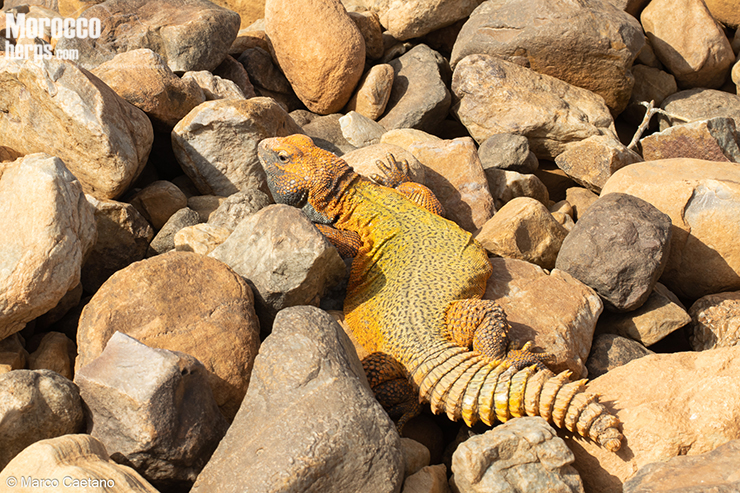





DAY 13 (21.05) – Guelmim – Sidi Ifni
Exploring the hills in between cities was paying off, and so we decided to focus on that. Between Guelmim and Sidi Ifni we found Malpolon monspessulanus (dead and alive), Psammophis schokari, Dasypeltis sahelensis, Bitis arietans (DOR), Agama bibronii, Chalcides polylepis, Eumeces algeriensis (dead), Saurodactylus brosseti, Tarentola chazaliae, Bufotes boulengeri and Pelophylax saharicus. The M. monspessulanus was, again, a very large male with 190cm, but a lot thinner than the one we had seen the day before. As we were driving, Marco said ‘There is a stick in the distance that looks like a snake… oh wait, it IS a snake!’. We managed to take a few nice photos before it returned to its refuge.




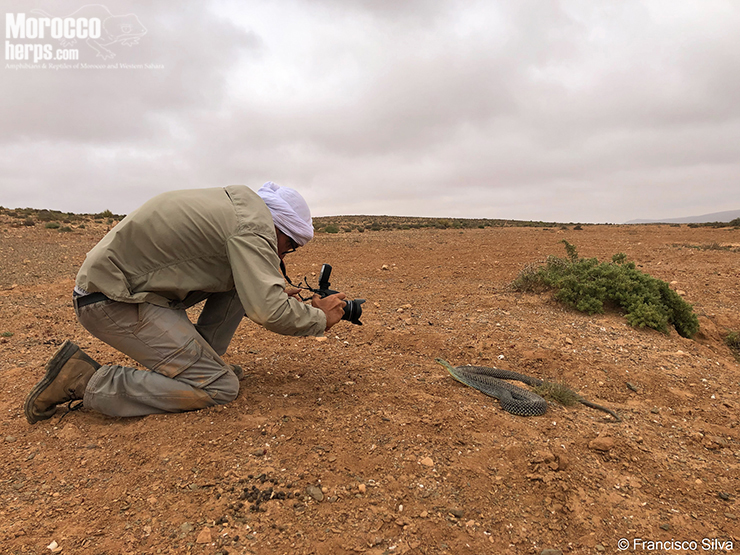
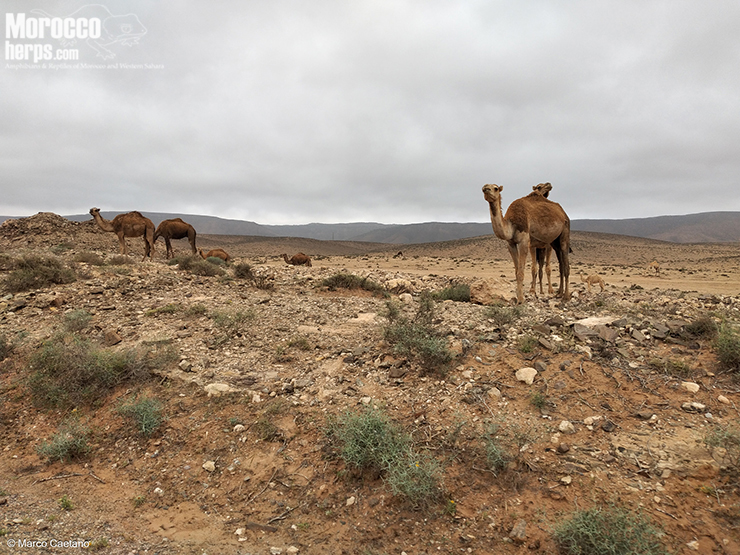


DAY 14 (22.05) – Sidi Ifni
This was our last full day in Morocco, and we took it rather easy, looking for Chamaeleo chamaeleon by the beach, but without luck. At night we saw Hemorrhois hippocrepis and our last Dasypeltis sahelensis – this was the last one we saw, which amounted to a total of six individuals on our trip. These guys were also a highlight of the trip, as we were not hoping to find so many. We guess the season was just right for them! That night we also saw two Bitis arietans DOR, a few more Tarentola chazaliae, a Bufotes boulengeri and an Algerian Hedgehog (Atelerix algirus).
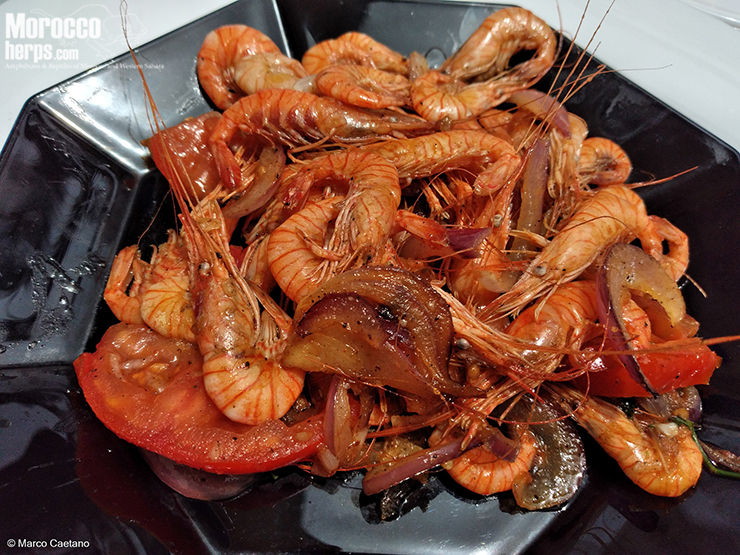






DAY 15 (23.05) – Sidi Ifni – Agadir
We had our flight back in the afternoon, and so we did not have time to do a lot more besides driving back to Agadir. Still, on the way we were presented with two Testudo graeca. One of them had just been hit by a car and had the shell cracked. Hopefully it made it through.
Just before reaching the airport, we decided to stop at a large aljibe next to the road, the last one of the trip and… we found nothing!

This ends our first trip to southwest Morocco. Some of the goals for this trip that we missed were Naja haje, Echis leucogaster, Daboia mauritanica, Telescopus tripolitanus, live Spalerosophis spp., Varanus griseus, Trogonophis wiegmanni and Eumeces algeriensis. Hopefully we’ll see them in September 2023 when we come back!

Video of our trip: https://youtu.be/qkiM8yTcm5Y

